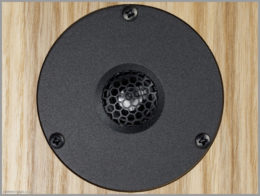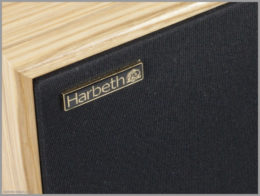My Story with Harbeth P3ESR 40th Anniversary
A good friend of mine which I already mentioned in other Harbeth reviews on this site, started his Harbeth journey with P3ESRs. He then moved up the Harbeth range, however, he always had a soft spot for the P3s. When Harbeth announced the release of the 40th Anniversary version, he wondered if he might replace his beloved Harbeth M30.1 with the new version of P3s. It was near the time when my friend and I were attending an opening of the new HiFi Corner store in Edinburgh. Apart from being a really great bunch of people, they also happened to be one of the biggest Harbeth dealers in the UK. After the opening, my friend managed to borrow their demo set of Harbeth P3ESR 40th Anniversary Edition. As well as sitting in on my friend’s listening sessions, this also gave me an opportunity to put this review together.
Speaker Info
Along with other models, Harbeth P3ESR 40th Anniversary Edition commemorates company’s 40th year or trading. All anniversary models are offered in limited edition veneers, and feature WBT Nextgen binding posts and British-made audio grade polypropylene film capacitors.
Harbeth P3ESR are the smallest speakers in their range and they are the successor to the legendary BBC LS3/5A, of which Harbeth had been a licensee. The speakers feature a 110mm Harbeth bass/mid unit, with the diaphragm made of a special blend of injection moulded polypropylene (patented by Harbeth and referred to as RADIAL2). The tweeter is a Seas unit, produced to Harbeth specification.
Harbeth P3ESR, similarly to other Harbeth speakers is designed to sound best in domestic environments at normal listening levels (i.e. 70dB to 90dB). It is optimised for use away from walls and with tweeters at ear level.
Harbeth P3ESR Specs
| Frequency Response: | 75 – 20,000Hz (+/- 3dB) |
| Sensitivity: | 83.5dB (1W input, measured at 1m) |
| Impedance: | 6Ω |
| Power Handling: | 50W |
| High Frequency Driver: | Seas 25mm Soft Dome Tweeter |
| Low Frequency Driver: | Harbeth 110mm RADIAL2™ Cone Woofer |
| Crossover Frequencies: | Unknown |
| Enclosure Type: | Closed |
| Enclosure Dimensions (HxWxD): | 306x190x184mm (12×7.5×7.25″) |
| Weight: | 6.1kg (each speaker) |
| Production Year: | 2018 – 2020 |
| Price When Launched: | £2,495 |
Look & Feel of Harbeth P3ESR 40th Anniversary
To anyone familiar with Harbeth’s design philosophy, it will come as no surprise that Harbeth P3ESR 40th Anniversary speakers are made from thin MDF walls veneered on both sides. It is a BBC originated design, where front and rear panels are screwed on, and all the walls inside are dampened with bitumen pads. The idea behind this design is not only to reduce enclosure ringing, but also to tune cabinet resonances so they fall way below critical midband frequencies. A very different approach to most other manufacturers that try to make enclosures infinitely ridged.
The veneer on each enclosure is matched, and then both enclosures are matched with each other. It has a light satin varnish finish, and you can see and feel the wood texture – I really like this. This pair was veneered in olive wood veneer and finished with a clear coat. The edges of the woofer mounting hole were painted black. I’m guessing that if they were not, there would be too much contract between clear coated olive wood veneer and clear coated MDF – not something you’d want to see in £2,500 bookshelf speakers. The binding posts for this anniversary edition are the rather expensive looking WBT Nextgen. To emphasise that these are WBT posts, there is a plastic ‘WBT’ label near the posts. I personally find this a little naff and unnecessary, and a step away from the down-to-earth Harbeth design, where solid engineering is appreciated more than marketing. On the other hand, businesses exist to make money, and there is clearly a demand for these type of ‘upgrades’. The grills are the same design as in all other Harbeth speakers – thin metal frame with fabric stretched over it. The frame slides into narrow groves in the front panel of the speakers and it is held there only by friction. It is a good design because it prevents side reflections that you may find is more traditional thick wooden grilles, but it is not a great design from a usability point of view. However, the grilles were not really designed to be remove from the speakers. I’ve seen people removing these by inserting paper clips or other sharp objects between the metal frame and the groove, and damaging the grille fabric as a consequence. I found that removing these with neodymium magnets is by far the easiest and least invasive method.
Both the Seas tweeter and Harbeth mid-bass unit appear to be very well made. The crossover is very complicated especially when compared with other 2-way shoe box size speakers available on the market. The crossover components appear to be of a good quality, but you will not find large air-core inductors here. What you will find is some audio grade film capacitors which Harbeth is not shy about in their marketing literature. It seems that it is another ‘upgrade’ driven by the consumer demand rather than an objective need. On the other hand, it is an anniversary version of a premium speaker, so why not?
Overall, Harbeth P3ESR 40th Anniversary speakers are very well made and beautiful, especially without the grills. According to Harbeth, the speakers where designed, tuned and measured with the grilles on, and this is how they are supposed to be listened to. Shame, as in my opinion there is something very appealing about the look of small monitor speakers without the grilles. Nonetheless, having grilles on is definitely a better idea, especially if you live in a house with ‘curious fingers’ running around.
Sound of Harbeth P3ESR 40th Anniversary
I previously experienced the original Harbeth P3ESRs in my living room, but this was before I was able to give Harbeths enough time to appreciate their qualities. I was therefore looking forward to trying the Harbeth P3ESR 40th Anniversary Edition. I started with side by side comparisons against my Harbeth M40.1 – a very interesting auditory and visual experience to see the biggest and the smallest Harbeth speakers next to each other. I then compared them side by side with my Harbeth M30.1, before I removed all other speakers from the room and concentrated on the P3s.
My initial impressions were that Harbeth P3ESR 40th Anniversary demonstrate a different tonal balance than the M30.1s and M40.1s. They appeared a little brighter and (not surprisingly) more limited in the bottom end area. Strange thing is, that when you play previously unheard recordings, you don’t really notice the lack of bottom end. When my friend came over and I played him a fairly bass rich track Ne Kuni Me, Ne Ruzi Me Majko by Ljiljana Buttler, he thought that the M40.1 were playing… It just shows that you only miss bottom end on P3s, if you heard it on a particular track before. What is also surprising about Harbeth P3ESR 40th Anniversary is the kick, which took me by surprise when playing Water of Love by Dire Straits. Don’t get me wrong, you’re not going to blow out the candles with them, but considering their tiny size, they offer a very good level of dynamics and details in the upper bass. What you are not going to get is the visceral experience, which incrementally increases as you move up the Harbeth range. Sometimes you can just tell that the speakers sound a little forced – not as effortless as their bigger speakers. When you switch directly from big full range speakers to P3ESRs, the small Harbeths sound like computer speakers… But this is something that all small monitors suffer from.
The midrange and treble are of very high quality which I almost take for granted after reviewing all other models in the Harbeth range. Vocals sound natural and open, but not as warm and full-bodied as on the M30.1s. If I was to compare their tonal balance to another speaker in the Harbeth range, it would the Super HL5 Plus. Hence the P3s may suit listeners with preference for more open and airy sound. My personal preference leans toward warmer voicing of the M30.1s which is not quite as airy but more natural to my ears. On the other hand, the more open sound of P3s seem to suit tracks like Book Faded Brown by The Band, where it is easier to distinguish between different voices singing together. String instruments sound great and realistic. Acoustic guitars have more spark and air than on the M30.1s but not as much body and warmth to them. Bass guitars and double bass don’t sound as realistic as on larger Harbeth speakers, presumably as a result of limited bottom end extension. Brass instruments sound very good.
Similarly to Super HL5 Plus and Monitor 30.1s, clapping sounds very real, which helps with creating the 3D sound stage illusion that Harbeth speakers are well known for. To achieve this, the speakers of course have to be placed correctly in the listening room – i.e. certain distance away from walls. All of the above mentioned qualities make the Harbeth P3ESR 40th Anniversary Edition a joy to listen to if you are willing to accept their limitations.
If you are after mini monitors and like your speakers to be forgiving but you have a preference for a more open and airy sound, I could not think of any better speakers than these.
Conclusion
Harbeth P3ESR 40th Anniversary Edition speakers are very well-balanced and open sounding speakers, with outstanding midrange clarity and impressive bottom end considering their tiny cabinet size. Very forgiving, can be enjoyed for hours. They would make a great desktop setup or a perfect system for a very small room, however, if you are looking for an ultimate HiFi experience for your main listening room, there are much better speakers out there that could be purchased for a lot less money. To my ears, speakers such as Wharfedale Linton Heritage outperform Harbeth P3ESR in every aspect and you could get two sets of them with stands for the current price of P3s!
| Balance of Sound: | |
| Neutrality of Tone: | |
| Transparency: | |
| Soundstage: | |
| Attack: | |
| Engagement: | |
| Total Score: |
Songs Mentioned In This Review
The Band – Book Faded Brown
Dire Straits – Water of Love
Ljiljana Buttler – Ne Kuni Me Ne Ruzi Me Majko
Reviewed: June 2019 | Published: November 2019













